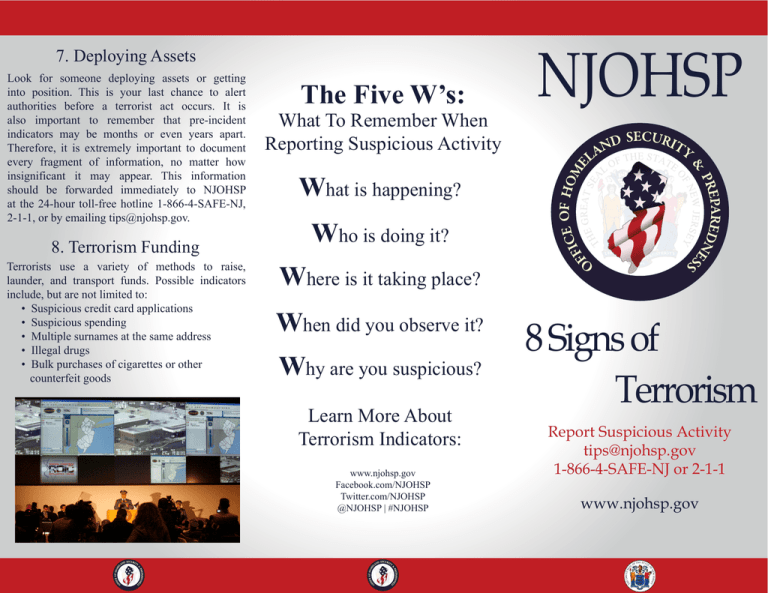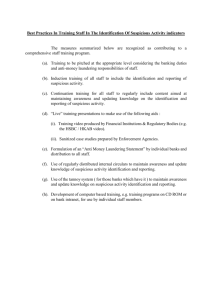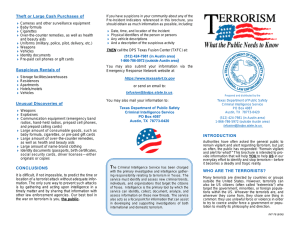NJOHSP The Five W’s:
advertisement

7. Deploying Assets Look for someone deploying assets or getting into position. This is your last chance to alert authorities before a terrorist act occurs. It is also important to remember that pre-incident indicators may be months or even years apart. Therefore, it is extremely important to document every fragment of information, no matter how insignificant it may appear. This information should be forwarded immediately to NJOHSP at the 24-hour toll-free hotline 1-866-4-SAFE-NJ, 2-1-1, or by emailing tips@njohsp.gov. 8. Terrorism Funding Terrorists use a variety of methods to raise, launder, and transport funds. Possible indicators include, but are not limited to: • Suspicious credit card applications • Suspicious spending • Multiple surnames at the same address • Illegal drugs • Bulk purchases of cigarettes or other counterfeit goods The Five W’s: What To Remember When Reporting Suspicious Activity NJOHSP What is happening? Who is doing it? Where is it taking place? When did you observe it? Why are you suspicious? Learn More About Terrorism Indicators: www.njohsp.gov Facebook.com/NJOHSP Twitter.com/NJOHSP @NJOHSP | #NJOHSP 8 Signs of Terrorism Report Suspicious Activity tips@njohsp.gov 1-866-4-SAFE-NJ or 2-1-1 www.njohsp.gov 1. Surveillance 3. Tests of Security The first sign of terrorism is someone trying to monitor or record activities. If terrorists are targeting a specific area, they will most likely be observed in that location during the planning phase. Terrorists will attempt to determine the strengths, weaknesses, and number of personnel that may respond to an incident. Routes to and from the target are usually established during the surveillance phase. It is important to note the following suspicious actions: • Using cameras (still or video) • Drawing diagrams or annotating maps • Using vision-enhancing devices • Possessing floor plans or blueprints of places such as high-tech firms, financial institutions, or government and military facilities. Any of these acts may be an indicator that something is not right, and they should be reported immediately. Tests of security or probing are techniques terrorists use to gather data. These are usually conducted by driving past or even penetrating the target, moving into sensitive areas, and observing security and law enforcement responses. Terrorists may also try to penetrate physical security barriers or test response procedures to assess strengths and weaknesses. Specific areas of interest might include the number of response personnel and routes taken to a specific location. Vehicles parked for unusually long periods of time, sometimes in no-parking zones, are another test of security. Another pre-incident indicator is observing suspicious people who do not belong. The suspicious person could be anyone in a building, neighborhood, or business establishment who seems out of place because of their demeanor or who asks unusual questions. Suspicious persons could also include stowaways aboard ships or people jumping ship in ports. • We do not profile individuals. We profile behaviors. 4. Acquiring Supplies A dry run may be the heart of an attack’s planning stage. Before the execution of an operation, a practice trial is usually run to work out any flaws or unanticipated problems. This is especially true for kidnappings and bombings. If you see someone monitoring a police radio frequency and recording response times, you may be observing a dry run. 2. Elicitation/Seeking Information The second sign is an attempt to gain information through inquiries, including seeking knowledge about a place, person, or operation. Elicitation can be made by telephone, mail, fax, or in person. Examples include inquiries about critical infrastructure such as a power plant, water reservoir, or maritime port. Terrorists may attempt to research bridge and tunnel use, make unusual inquiries concerning shipments, or look into how a facility operates. They may also attempt to place “key” people in sensitive work locations to gain intelligence. www.njohsp.gov The fourth sign of terrorism includes the purchase or theft of explosives, weapons, or ammunition. It could also include unusual purchasing or storing of fertilizer or harmful chemicals. Terrorists also find it useful to acquire law enforcement equipment and identification, military uniforms and decals, and flight passes, badges, or manuals. Terrorists often use false or stolen identification documents, including passports and driver’s licenses. They may try to produce counterfeit identification by photocopying. Any of these items would facilitate entry to secure or prohibited areas. Anyone wearing a uniform or working at a sensitive facility should protect their identification documents. 5. Suspicious People 6. Dry Run “If You See Something, Say Something.” @NJOHSP ohsp@njohsp.gov





